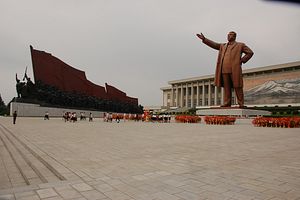As expected, North Korea staged a major military parade through Pyongyang’s Kim Il Sung Square on Sunday to celebrate the 70th anniversary of its founding on September 9, 1948. The parade, unlike the parade earlier this year in February, was attended by both senior foreign dignitaries and received coverage by international media.
The presence of foreign dignitaries at the summit was significant. It underlined that, contrary to the United State’s efforts to isolate North Korea last year, Pyongyang still had many friends. Two envoys that received particular focus in North Korea’s domestic coverage of the foundation day celebrations were Chinese President Xi Jinping’s special representative, Li Zhanshu, a member of the Communist Party of China’s Politburo Standing Committee, and Valentina Matvienko, the speaker of the upper house of the Russian parliament.
Unlike the parade in February, however, Sunday’s parade was notable for the complete absence of any nuclear-capable missile systems. The heaviest pieces of military hardware on display, based on the limited imagery released by foreign media that were present, included the KN06/Pongae-5 surface-to-air missile system, self-propelled artillery guns, and multiple rocket launch systems. Like in February, North Korea chose not to broadcast the parade as it occurred on its state television network.
That North Korea chose to withhold its nuclear-capable systems, including the intercontinental-range ballistic missiles (ICBM) capable of striking the continental United States, is significant and speaks to the shift in the country’s strategic focus announced earlier this year by Kim Jong Un.
Speaking before the Workers’ Party of Korea’s Central Committee in April, Kim announced a “new strategic line” for North Korea, that would see the country’s efforts directed almost entirely toward economic and scientific betterment. Kim announced the success of his older byungjin line, adopted in 2013, that privileged the parallel pursuit of nuclear weapons and economic betterment.
As long as byungjin remained in place, North Korea not only worked toward crossing the final milestones of a thermonuclear weapon and an ICBM by which to deliver it to the United States, but constantly reminded the United States — and the world — of its growing capabilities.
With the successful flight-test of the Hwasong-15 ICBM in November 2017, Kim declared the completion of North Korea’s nuclear deterrent and, after calling for the mass production of warheads and ballistic missiles during his January 1 New Year’s Day address this year, reduced the overall prominence of his nuclear forces in both internal and external propaganda.
Notably, North Korea did allow both the Hwasong-14 and Hwasong-15 ICBM to see the parade limelight at least once in Pyongyang. Both missiles rolled through Kim Il Sung Square on February 8 this year, just one day before the opening of the PyeongChang Winter Olympics in South Korea, which also incidentally marked the beginning of inter-Korean rapprochement that has held momentum to this day.
Withholding nuclear-capable assets from the September parade also lessens pressure on the currently logjammed U.S.-North Korea diplomatic process. Had Kim shown off his ICBMs, U.S. President Donald J. Trump may have reacted unpredictably and, most probably, negatively. After their summit meeting in Singapore on June 12, Trump had declared that there was “no longer a nuclear threat” from North Korea. Kim chose not to prove the U.S. president wrong in an overt way on Sunday.
While the lack of ICBMs in the parade won’t facilitate the emergence of common ground between Washington and Pyongyang on “denuclearization,” it does highlight what is perhaps the emergence of a new era of opacity in North Korea about its nuclear capabilities. In 2016 and 2017, the international community grew accustomed to nearly biweekly provocations from North Korea as it worked to perfect its nuclear deterrent. That is no longer the case; the country hasn’t launched a single missile since November 2017.
With Kim having declared the completion of his deterrent and shifted focus to the economy, North Korea’s nuclear forces are likely to become less prominent overall in the country’s external signaling now. As the January 1 speech made clear, North Korea is now fleshing out its nuclear forces with mass production. As it deploys a more robust and growing nuclear force, it’ll seek to avoid the limelight. Indeed, part of the reason the ICBMs are unlikely to be called out to Pyongyang is because they may already be deployed in the northern part of the country, where North Korea maintains its so-called “ballistic missile operating areas.”
In many ways, this is North Korea operating more like regular nuclear powers do. While it may not pursue the total opacity that a nuclear power like Israel adopted — especially given the long history of prominent and overt signaling of its nuclear capability — Pyongyang may treat the public presentation of its nuclear weapons capability more in the way that India or Pakistan do.
Above all, for North Korea, nuclear weapons are now being framed as an enabler of the country’s ability to securely pursue economic development under the “new strategic line.”

































